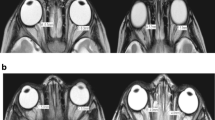Abstract
Introduction
Serial change in ventricular size is recognized as an imperfect indicator of ongoing hydrocephalus in children. Potentially, other radiographic features may be useful in determining the success of hydrocephalus interventions. In this study, optic nerve sheath diameter (ONSD), optic nerve tortuosity, and optic disk bulging were assessed as indicators of hydrocephalus control in children who underwent endoscopic third ventriculostomy (ETV) or posterior fossa tumor resection.
Methods
Sixteen children underwent ETV or tumor resection for treatment of hydrocephalus. T2-weighted axial magnetic resonance images of the orbit were obtained, and the ONSD was measured posterior to the optic globe, pre- and post-intervention. Evidence of optic disk bulging and optic nerve tortuosity was also assessed. Ventricular size was estimated using the frontal and occipital horn ratio (FOR).
Results
There was a significant reduction in the ONSD post-ETV (n = 9) and after tumor resection (n = 7). Average preoperative ONSD was 6.21 versus 5.71 mm postoperatively (p = 0.0017).There was also an 88 % (p = 0.011) and 60 % (p = 0.23) reduction in optic disk bulging and tortuosity, respectively. The FOR normalized in the tumor resection group but not the ETV group. After intervention, all patients showed improvement in signs and symptoms of hydrocephalus.
Conclusion
In our study population, ONSD decreased in response to measures to reduce hydrocephalus. Optic disk bulging also appears to resolve. Serial reduction in ONSD, and optic disk bulging may be indicators of improved hydrocephalus following pediatric neurosurgical interventions.

Similar content being viewed by others
References
Rekate HL (2008) The definition and classification of hydrocephalus: a personal recommendation to stimulate debate. Cerebrospinal Fluid Res 5:2
Bruce DA, Weprin B (2001) The slit ventricle syndrome. Neurosurg Clin N Am 12:709–717
Engel M, Carmel PW, Chutorian AM (1979) Increased intraventricular pressure without ventriculomegaly in children with shunts: "normal volume" hydrocephalus. Neurosurgery 5:549–552
Kulkarni AV, Drake JM, Armstrong DC et al (2000) Imaging correlates of successful endoscopic third ventriculostomy. J Neurosurg 92:915–919
Santamarta D, Martin-Vallejo J, Diaz-Alvarez A et al (2008) Changes in ventricular size after endoscopic third ventriculostomy. Acta Neurochir (Wien) 150:119–127, discussion 127
Gnanalingham KK, Lafuente J, Thompson D et al (2003) The natural history of ventriculomegaly and tonsillar herniation in children with posterior fossa tumours—an MRI study. Pediatr Neurosurg 39:246–253
Watanabe A, Kinouchi H, Horikoshi T et al (2008) Effect of intracranial pressure on the diameter of the optic nerve sheath. J Neurosurg 109:255–258
Lam BL, Glasier CM, Feuer WJ (1997) Subarachnoid fluid of the optic nerve in normal adults. Ophthalmology 104:1629–1633
Lim MJ, Pushparajah K, Jan W et al (2010) Magnetic resonance imaging changes in idiopathic intracranial hypertension in children. J Child Neurol 25:294–299
Brodsky MC, Vaphiades M (1998) Magnetic resonance imaging in pseudotumor cerebri. Ophthalmology 105:1686–1693
Jinkins JR, Athale S, Xiong L et al (1996) MR of optic papilla protrusion in patients with high intracranial pressure. AJNR Am J Neuroradiol 17:665–668
O'Hayon BB, Drake JM, Ossip MG et al (1998) Frontal and occipital horn ratio: a linear estimate of ventricular size for multiple imaging modalities in pediatric hydrocephalus. Pediatr Neurosurg 29:245–249
Pakzad-Vaezi K, Cochrane D, Sargent M et al (2009) Conventional and diffusion-weighted magnetic resonance imaging findings in a pediatric patient with a posterior fossa brain tumor and papilledema. Pediatr Neurosurg 45:414–418
McAuley D, Paterson A, Sweeney L (2009) Optic nerve sheath ultrasound in the assessment of paediatric hydrocephalus. Childs Nerv Syst 25:87–90
Newman WD, Hollman AS, Dutton GN et al (2002) Measurement of optic nerve sheath diameter by ultrasound: a means of detecting acute raised intracranial pressure in hydrocephalus. Br J Ophthalmol 86:1109–1113
Killer HE, Jaggi GP, Miller NR (2009) Papilledema revisited: is its pathophysiology really understood? Clin Experiment Ophthalmol 37:444–447
Acknowledgments
The authors gratefully acknowledge the work of Michael Kerr, who assisted in manuscript preparation and editing.
Conflict of interest
The authors would like to declare that no conflict of interest exists.
Ethics
Ethical approval for this study was provided by the University of British Columbia and Children's and Women's Health Centre Research Ethics Board, approval number: H11-02644. All research activities were performed in accordance with the ethical standards of good clinical practice as outlined in the 1964 Declaration of Helsinki.
Author information
Authors and Affiliations
Corresponding author
Additional information
Portions of this work have been accepted for abstract presentation at the AANS/CNS Section on Pediatric Neurological Surgery Meetings in November 2011 and the Western Medical Student Research Forum in January 2012.
Rights and permissions
About this article
Cite this article
Singhal, A., Yang, M.M.H., Sargent, M.A. et al. Does optic nerve sheath diameter on MRI decrease with clinically improved pediatric hydrocephalus?. Childs Nerv Syst 29, 269–274 (2013). https://doi.org/10.1007/s00381-012-1937-z
Received:
Accepted:
Published:
Issue Date:
DOI: https://doi.org/10.1007/s00381-012-1937-z




